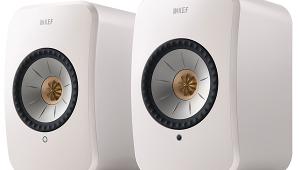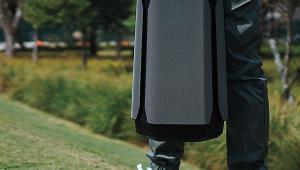Ik ben altijd op zoek naar nieuwe online casino’s en kwam toevallig https://redonbet.be tegen toen ik op internet aan het surfen was. Hier in België heb je veel keuzes, maar niet elke site is even betrouwbaar. Wat me hier aantrok, was de variatie aan spellen en de bonussen die ze aanbieden. Ik speelde een paar ronden en had meteen plezier. Het inzetten is eenvoudig en de winsten kunnen snel worden opgenomen, dus ik blijf hier voorlopig nog even hangen!
Review: Bowers & Wilkins A7 AirPlay Speaker

When B&W launched the Zeppelin back in 2007, it created a whole new category: the high-end lifestyle audio system. The Zeppelin cost a whopping $599, but it sounded much better than the other iPod docks of its time, it looked like no other audio product in history, and it sold like crazy. In the Zeppelin’s original version and in the AirPlay-compatible Zeppelin Air, B&W has sold hundreds of thousands of units.
Still, for a lot of people the Zeppelin’s elliptical shape is just too weird. For them, B&W just launched two visually tamer alternatives: the $499 A5 and the $799 A7. It’s hard to imagine anyone would object to these systems’ sleek, simple look — unless you feel the need to grab your guests’ attention with a really wacky-looking audio system.
Neither unit has the Zeppelin Air’s iPod dock, which was obsoleted when Apple introduced the 9-pin Lightning connector in the iPhone 5. Both rely primarily on Apple’s AirPlay wireless system as a sound source, so anything that plays in iTunes or on an iPhone, iPad, or iPod touch will play on them.
The larger A7 reviewed here improves on the smaller A5 by adding a USB input for use with computers, and a built-in 6-inch subwoofer to augment its 1-inch tweeters and 3-inch midranges. It also has a lot more amp power: 25 watts for each mid and tweet, plus another 50 for the sub. A large port on the rear reinforces the sub’s output.
AirPlay on the way
Unless you use the USB or 3.5mm analog input, the A7 doesn’t do much until you set up its AirPlay capability. You can do this as I did, though a Mac or PC, which involves downloading a program from B&W’s website, installing it on your computer, and punching in the password for your WiFi router. (You can also use a wired Ethernet connection.) Or you can set up the A7 by downloading B&W’s iOS app and using your iPhone, iPad, or iPod touch to carry out the task. Once it’s all working, you can stream music to the A7 from the computer or your iOS device. As with other AirPlay devices, you can set up several in your home and use them independently or in concert.
The only controls on the unit are volume + and – buttons on the right side. The included, oval-shaped remote has power, volume +/-, track skip, play/pause, and source select controls. The track skip and play/pause controls worked with my iPod touch and with the Media Monkey and Windows Media Player software on my PC, but not with iTunes. (So much for the vaunted user-friendliness of Apple products.) Of course, you can control volume and select tunes from your computer, tablet, or phone.
I also tried listening through a USB connection, and was very happy to find that the A7’s USB input could handle the 24/96 HDtracks download of Eric Dolphy’s Out to Lunch, played through Media Monkey.
A7 to ZZ Top
Because I wanted to get a review going of the A7 ASAP, I carried it straight from my UPS guy’s hands into my office, ran the AirPlay setup, and immediately began cranking ZZ Top’s new La Futura album to give the drivers a good break-in. They probably didn’t need it; the unit sounded really good right out of the box. What’s more, it really rocked.
On “I Don’t Wanna Lose, Lose You,” the A7’s 6-inch internal sub kicked in hard. Bassist Dusty Hill’s deep, nasty groove didn’t shake my floor, but at least it got my head bobbing hard. When I later moved the A7 out into my big listening room, it easily filled the larger space. If you crank the A7 all the way up, the subwoofer runs out of gas and the sound gets bright, but if you keep it two or three clicks down you’re safe.
Moving down the iTunes playlist on my laptop, I clicked on Miles Davis’s “What It Is” (from Decoy), and the power of bassist Darryl Jones’s explosive slapped intro actually scared me a little. For an AirPlay speaker, that’s an impressive feat. Once the other instruments kicked in, I had to turn it down a bit; in this case, it sounded like the midrange drivers were running out of gas, which created a bit of a “hole” between the mids and the woofer, and shifted the tonal balance to the bright side. But lowering the level a couple of notches to a still very satisfying 92 dB SPL from my listening chair brought out the best in the A7. The trumpet, sax, guitar, and keyboards all sounded pretty neutral, with none of the obvious colorations one usually hears in a compact system like this, and I ended up listening to the rest of Decoy through the A7 just ’cause I was enjoying the sound so much.
This is where the A7 really gets an advantage over most dock and wireless speaker products. So many of them have fairly gross sonic colorations that make serious listening pointless. With the A7, I found myself getting much fussier than I might with most products in its category, much as I would when doing a review of a conventional speaker.
Even many complex mixes, such as my go-to speaker test cut, Steely Dan’s “Aja,” sounded terrific through the A7. The built-in sub, especially, really kept this tune grooving, with what sounded like a mild emphasis in the region around 80 to 100 Hz that gave the bass a little extra definition, punch, and groove. Donald Fagen’s tough-to-reproduce voice sounded shockingly smooth, and while the closely spaced speakers didn’t give me any real stereo effect, the big sound of this little box certainly gave me the subjective impression of room-filling sound.
Although Wayne Shorter’s sax solo on “Aja” sounded great, I did notice when listening to “Scoops,” from Sonny Rollins and the Modern Jazz Quartet, that the A7 seemed to have a mild mid-treble emphasis that made some sax players sound a tad edgy. I noticed this effect with some other instruments, too — notably the cymbals in “Straight Up and Down” from that Dolphy side mentioned above.
Some sonically dense mixes, such as Led Zeppelin’s “Dancing Days” and Todd Rundgren’s “For the Want of a Nail” proved a little too much for the A7 to sort out. It still sounded good, but it was hard to pick the individual instruments out in the mix. Not that I can think of a compact AirPlay, Bluetooth, or dock-type product that would sound any better with this material, but I thought I should add this comment for those who are choosing between the A7 and, say, a desktop system with more conventional speakers that would likely do a better job with these kinds of tunes.
While the A7 is technically a stereo device, its internal speakers are spread only about 9 inches apart, and it doesn’t seem to have any virtualization or stereo enhancement technology, so the sound is basically confined to the box. Adrian Belew’s “May 1, 1990” (from Here), one of my reference tracks for stereo soundstaging, sounded good through the A7, but it didn’t sound spacious. Same thing with pianist András Schiff’s recording of J.S. Bach’s “Italian Concerto in F major”: great sound, just not great stereo.
Measurements
Frequency response
53 Hz to 20 kHz ±3.5 dB on-axis, ±3.0 dB to 10 kHz, ±3.2 dB avg 0-30°
Bass output (CEA-2010A standard)
- Ultra-low bass (20-31.5 Hz) average: 81.9 dB
20 Hz NA
25 Hz 79.9 dB
31.5 Hz 88.4 dB
- Low bass (40-63 Hz) average: 105.2 dB
40 Hz 100.3 dB L
50 Hz 104.1 dB L
63 Hz 109.1 dB L
To measure the quasi-anechoic frequency response of the A7, I set it atop a 2-meter stand and placed the microphone at a distance of 1 meter. (Quasi-anechoic measurements eliminate reflections from surrounding objects to simulate measuring in an anechoic chamber.) The microphone was placed on the same axis as the left tweeter, which is where I got the smoothest response. I then ran a ground-plane measurement at 1 meter to get the bass response. To create the graph shown here, I spliced the bass response to the 0° on-axis response (blue trace) of the left channel only, and to the average of quasi-anechoic measurements (green trace) of the left channel only taken at 0°, ±10°, ±20°, and ±30°. I used a Clio FW analyzer in MLS mode for the quasi-anechoic measurements and log chirp mode for ground plane, feeding test signals into the A7’s 3.5mm line input. The quasi-anechoic measurements were smoothed to 1/12th octave.
The A7’s on-axis and averaged frequency responses are outstanding—within ±3.5 dB worst-case, which is a feat few conventional speakers can match, so for a wireless all-in-one speaker it’s especially impressive. It would be even better but for a moderate tweeter resonance at 16 kHz, which will be audible to few, if any, listeners.
My listening sessions with the A7 indicated that its bass response is pretty strong, so I decided to include full CEA-2010 bass output measurements here. I did the measurements at 1 meter because the A7’s output wasn’t strong enough to do them at the usual 3 meters. Averages are calculated in pascals per CEA-2010A procedure. Because I couldn’t get a measurement at 20 Hz, I subtracted -18 dB from the 25 Hz result to get the ultra-low bass average. An L appears next to those measurements that were dictated by the unit’s internal limiter.
The A7’s bass output is the best I can remember measuring for an audio product of this type. comparable to that of the small subwoofers that come with 2.1-channel soundbars.
When I did my MCMäxxx™ test, in which I crank up Mötley Crüe’s “Kickstart My Heart” until it sounds distorted then back it off one notch and measure the output at 1 meter, I got a whopping 97 dBC out of the A7. That’s impressive, although a few dB short of the level I got with the Samsung DA-E750. At higher levels, the sound got bright and blaring.
Bottom line
I always feel like a weaselly wuss when reviewing wireless audio systems like the A7. That’s ’cause it ain’t just about the sound, it’s about the features, the form factor, and the price.
For example, I like the A7’s sound a little better than the Samsung DA-E750’s, but I’d buy the Samsung because its built-in Bluetooth works with my Android phone. Likewise, some people prefer a bigger stereo effect; they’ll dig something like the Edifier Spinnaker. Or maybe a desktop system with separate speakers—you know, the kind that audiophile writers always insist everyone should buy instead of wireless speakers.
So here’s my weaselly, ridiculously qualified recommendation: If you’re looking for a compact system that can fill a room with sound, and you’re an Apple-centric person, and $800 is within your budget, you should run right down to the Apple store, crank up an A7, and annoy the hell out of the staff until they tell you to either leave or buy it. In which case, you’ll probably buy it.
- Log in or register to post comments
































































